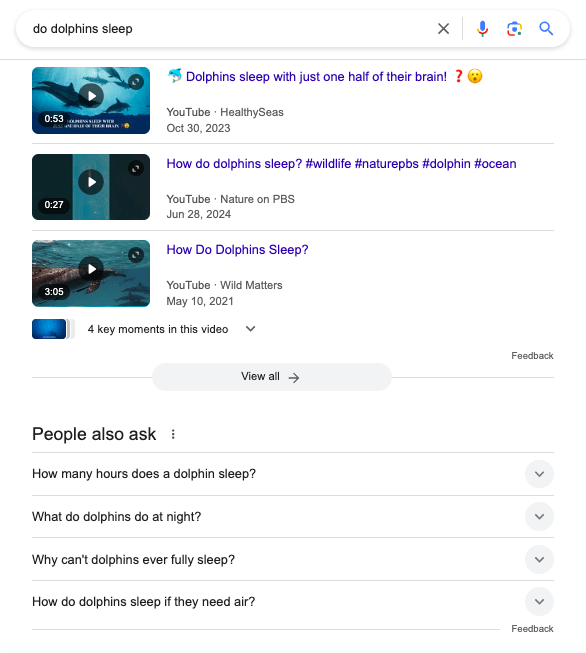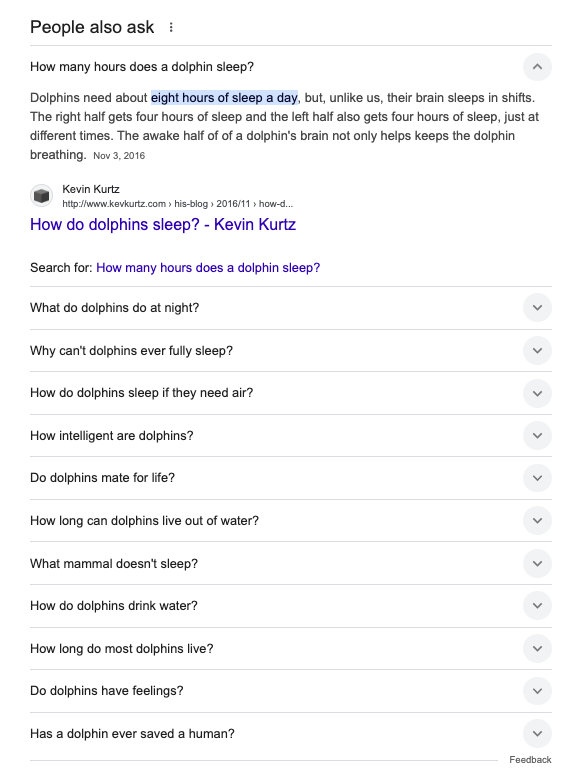The “People Also Ask” (PAA) feature is a dynamic component of Google’s search engine results pages (SERPs) that provides users with additional related questions to their initial search query. These questions appear in a box and can be expanded to reveal concise answers that often link back to specific web pages in Google’s search results. PAA aims to give users quick, relevant information while encouraging them to dive deeper into related topics.
For businesses and content creators, appearing in the PAA section offers a significant opportunity to increase visibility, drive traffic, and build authority in a specific niche.
What is People Also Ask?
Google’s “People Also Ask” (PAA) is a feature that appears prominently in the search results, typically near the top of the page, just after the first organic listing. This feature displays a list of questions related to the user’s initial search query, providing a convenient way for users to explore related topics and find adjacent information. The PAA box is particularly useful for users who may not be sure how to phrase their queries or are uncertain about what they are looking for. By offering additional questions, PAA helps guide users to more precise and relevant information, enhancing their overall search experience.

How Does “People Also Ask” Work?
The “People Also Ask” feature operates by leveraging Google’s advanced algorithms, which analyze common search trends and user intent to generate a list of related questions. These algorithms consider various factors, including search history, current search trends, and how users interact with PAA boxes. By doing so, Google can predict and display questions that are likely to be relevant to the user’s initial query. The answers provided in the PAA section often follow a format similar to those found in Featured Snippets, offering concise and direct responses that link back to the source web pages.

Why Optimize for “People Also Ask” Within Search Engines?
Optimizing content to appear in Google’s PAA feature should be a key component of any SEO strategy, and here’s why:
- Enhanced Visibility: The PAA section usually appears near the top of search results, often before most organic listings. Being featured here increases the chances of users discovering your content without needing to scroll further.
- Increase in Organic Click-Through Rates (CTR): Content that appears in PAA gets more attention, leading to higher click-through rates. Users are more likely to visit a site that has already provided a useful answer to their question.
- Establishing Authority: When your content answers questions in the PAA box, it positions your site as a trusted source of information, boosting credibility and helping establish you as an authority in your field.
- Broader Keyword Coverage: By appearing in PAA, you target a broader array of long-tail keywords and related queries. This helps improve overall SEO performance and attracts users who may be interested in variations of your core topics.
- Voice Search Optimization: PAA results are often pulled for voice search queries. By optimizing for this feature, you’ll improve your chances of being found through voice searches, which are increasing in popularity.
How to Optimize for “People Also Ask”
Optimizing for the PAA section requires a thoughtful content strategy that aligns with both user intent and search engine algorithms. Here’s a step-by-step approach to optimize your content for Google’s “People Also Ask” feature.
1. Identify Common Questions in Your Niche
Start by researching the common questions users ask related to your industry or topic. Tools like SEMrush, Ahrefs, and AnswerThePublic can help identify relevant questions that appear in PAA boxes. Pay attention to the structure of these questions to ensure you’re targeting the right format. Experiment with different keyword variations in the search bar to uncover more specific questions that align with user intent and enhance visibility in search results.
2. Create High-Quality, Concise Answers
Google favors concise, yet thorough answers for PAA content. Typically, a short answer that appears in the PAA box is 40-60 words in length. Make sure to address the question directly, and then expand on it in the rest of your content.
For instance, if a user asks, “how to cook salmon in the oven?” your answer should be a clear, step-by-step process. Follow it with in-depth explanations further down in the article for those looking for more detail.

3. Use a Question-and-Answer Format in Your Content
To improve your chances of appearing in PAA, structure your content in a Q&A format. This helps Google’s algorithm easily identify relevant content and pull it into the PAA section. You can use H2 and H3 headers for each question, followed by clear and concise answers. Additionally, optimizing your content for a featured snippet by providing short, direct answers can further increase your visibility in search results.
4. Optimize for Long-Tail Keywords
The questions that appear in PAA tend to focus on long-tail keywords, which are often specific and reflect user intent. Conduct keyword research to identify these phrases and integrate them naturally into your content. With Google “People Also Ask,” the core answer individuals want is delivered in simple terms and a conversational tone.
5. Provide Comprehensive Coverage of Your Topic
Google’s algorithm looks for content that fully covers a topic. If your page answers multiple questions related to a core topic, you increase your chances of ranking in PAA for several different queries. Make sure to break your content into easily digestible sections that cover different aspects of a topic, and link to a web page where readers can find more comprehensive information.
Focus on Search Intent
When creating content for PAA, it’s crucial to focus on user intent. Ensure that your answers are aligned with what users are looking for, whether they’re seeking a quick fact, an in-depth explanation, or a solution to a problem.
Analyzing the ‘People Also Ask’ tree can provide valuable insights into related queries found in a Google search result.
7. Improve Page Load Speed and Mobile Usability
Since PAA content needs to load quickly, optimizing your page load speed and ensuring mobile-friendliness is essential. Google rewards fast, user-friendly pages with better visibility in SERPs and features like PAA.
Tools for Analyzing People Also Ask
Several tools can help you analyze and optimize for the “People Also Ask” feature. Tools like AlsoAsked, Botster, Frase, and KeywordsPeopleUse are designed to identify long-tail keywords and understand user search intent. These tools can also help you optimize your content for featured snippets and analyze your competitors’ presence on the SERPs. Additionally, SEO Minion is a valuable tool that can scrape the PAA section, providing insights into the questions and answers being featured for your targeted keywords. By leveraging these tools, you can gain a competitive edge in your SEO strategy and improve your chances of appearing in the PAA section.
Programmatic SEO and API Integration
Programmatic SEO and API integration can significantly enhance your SEO efforts by automating the process of content optimization and keyword research. Tools like AlsoAsked offer a sync/async API with webhook support, allowing for programmatic interaction with PAA data. This means you can integrate live PAA data into your tools or web apps, automating tasks such as content optimization, keyword research, and competitor analysis. By using programmatic SEO, you can scale your efforts more efficiently and stay ahead of the competition.
Access to ‘Zero Volume’ Keywords
The “People Also Ask” feature can help you uncover “zero volume” keywords—long-tail keywords that have low search volume but are still highly relevant to your topic. Tools like AlsoAsked can reveal these hidden gems, giving you a competitive edge in your keyword research. By targeting these keywords, you can create content that addresses specific user search intent, improving your chances of ranking higher in Google’s SERPs. This strategy allows you to tap into niche queries that your competitors might overlook, driving more targeted traffic to your site.
Saving Time with People Also Ask
Utilizing the “People Also Ask” feature can save you significant time in your keyword research process. Tools like AlsoAsked provide image exports and Bulk Searches, allowing you to quickly identify relevant questions and answers related to your topic. Additionally, the Deep Search feature can return an average of 150 questions per query, making it an invaluable resource for content ideation and keyword research. By leveraging these tools, you can streamline your research process, focus on creating high-quality content, and improve your chances of appearing in the PAA section.
By integrating these new sections, the article will provide a comprehensive guide to understanding and optimizing for Google’s “People Also Ask” feature, offering readers practical insights and actionable strategies to enhance their SEO efforts.
Why Should “People Also Ask” Be Part of Your SEO Strategy?
Integrating “People Also Ask” optimization into your SEO strategy offers numerous benefits, especially when considering Google’s focus on short answers and AI generative summations:
- Capture a Wider Audience: By optimizing for PAA, you cover a broader range of queries, attracting users at different stages of the buyer’s journey, from research to decision-making.
- Increase Click Potential: Content featured in PAA not only enhances your visibility but also taps into Google’s answer-driven results, leading to more clicks from users looking for quick, accurate information.
- Compete for Featured Snippets: Many PAA responses also serve as featured snippets. Optimizing for PAA increases your chances of landing these coveted spots, further boosting your traffic and authority.
- Boost Brand Authority: Providing valuable answers to frequently asked questions showcases your brand’s expertise and encourages users to see you as a go-to source of information.
- Lower Competition: Since not every business is optimizing for PAA, there is less competition compared to traditional organic search results. This provides a strategic advantage for those who prioritize it.
Frequently Asked Questions (FAQs) About “People Also Ask”
How does Google choose the questions in Google’s PAA feature?
Google’s algorithm pulls questions based on user queries and patterns it detects from similar searches. It aims to predict related information that users are likely to find useful.
2. Is it possible to appear in both the “People Also Ask” box and organic results?
Yes, it’s entirely possible for the same content to appear in both the PAA section and organic results, giving your content multiple touchpoints in the SERP and increasing its exposure.
3. Can PAA questions change over time?
Yes, PAA questions are dynamic and can change depending on shifts in search trends, user intent, and seasonality. This means ongoing optimization is important to maintain or improve your chances of ranking in PAA.
4. How do I track if my content is appearing in People Also Ask?
Tools like Ahrefs and SEMrush provide tracking features that allow you to monitor whether your content is featured in PAA boxes and other Featured Snippets. Additionally, you can manually search for your target keywords and check the SERPs.
5. Do answers in “People Also Ask” influence rankings?
While appearing in PAA can increase visibility and drive more clicks to your site, it doesn’t directly influence your ranking. However, the increased traffic and authority can indirectly boost your overall SEO performance.
Let Markitors Drive Your SEO Campaign
Our SEO and content specialists will help you apply these tips today to boost your visibility and drive better rankings. Contact us to learn more about our methods and wins.







